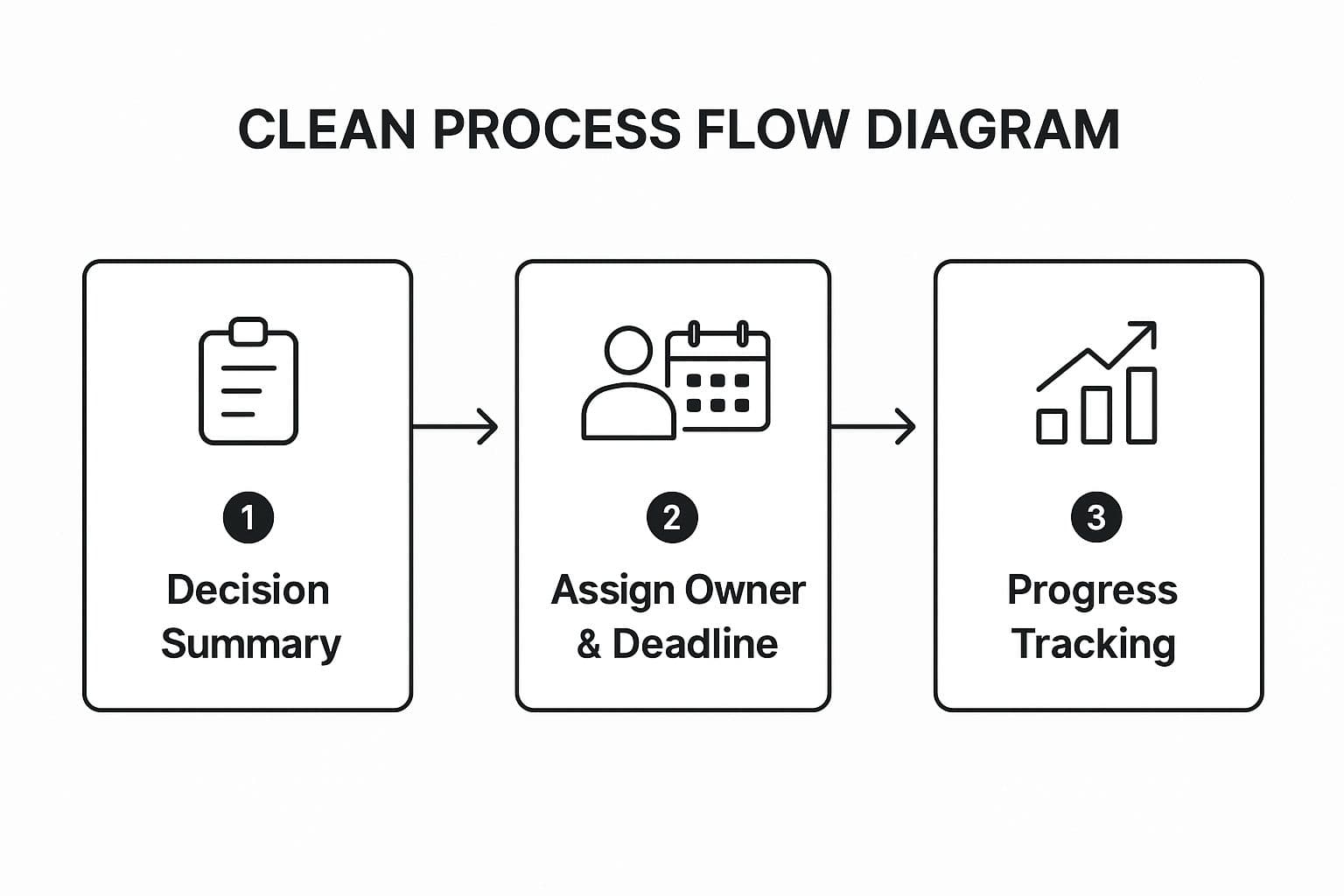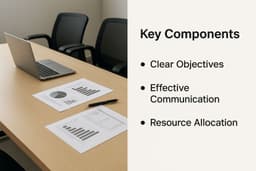Meeting minutes are more than just a record; they are a critical tool for accountability, legal compliance, and strategic alignment. A poorly chosen format can lead to missed action items, legal risks, and team confusion. A well-structured format, tailored to the meeting's purpose, transforms a simple document into a powerful driver of productivity and clarity. Choosing the right structure ensures that every participant, whether present or absent, understands key decisions and their assigned responsibilities.
This guide moves beyond generic templates to provide a strategic breakdown of six essential samples of meeting minutes format. We'll dissect each one, from formal board meetings to informal team stand-ups, to reveal its core strengths and weaknesses.
You will learn how to:
- Select the most effective format for specific meeting types.
- Structure your minutes for maximum readability and impact.
- Capture action items and decisions with precision.
We will analyze the structure, pros, cons, and tactical applications for each, empowering you to choose and implement the perfect format for any situation. Let's explore how to create minutes that get results, ensuring your documentation serves as a catalyst for action, not just an archive of conversation.
1. Corporate Board Meeting Minutes Format
The corporate board meeting minutes format is the most formal and legally rigorous of all meeting documentation styles. It serves as an official record of a board of directors' decisions, discussions, and actions. This format is less about capturing conversational flow and more about creating a compliant, defensible document that stands up to legal and regulatory scrutiny.

This structure is a cornerstone of good governance, providing a clear audit trail of the board's fiduciary duties. It is non-negotiable for public companies, non-profits, and any organization with a formal board structure, as these documents are often required for legal, financial, and compliance audits.
Strategic Analysis
The primary strategy behind this format is risk mitigation. Every element is designed to protect the organization and its directors from legal liability. It achieves this by documenting adherence to bylaws, recording votes precisely, and noting any conflicts of interest. The language is intentionally objective, formal, and devoid of personal opinions or verbatim quotes unless a specific motion requires it.
The structure follows a strict, predictable order, often guided by parliamentary procedures like Robert's Rules of Order. This ensures every meeting is conducted and documented consistently, reinforcing procedural correctness.
Actionable Takeaways & Best Practices
To effectively implement this sample of meeting minutes format, focus on precision and procedure.
- Follow a Strict Template: Work with legal counsel to establish a locked-down template. It should include mandatory sections like Call to Order, Attendance and Quorum, Approval of Previous Minutes, Conflict of Interest Disclosures, Committee Reports, Old and New Business, and formal resolutions.
- Document Motions and Votes Exactly: Record the exact wording of each motion, who moved it, and who seconded it. Document the outcome of the vote clearly (e.g., "Motion passed unanimously," or "Motion passed with 5 in favor, 2 opposed, 1 abstention").
- Train the Secretary: The person taking minutes (often the Corporate Secretary) must be trained in formal minute-taking and the basics of parliamentary procedure. Their role is to be an impartial recorder of official actions. For a deeper dive, explore our guide covering meeting minutes best practices for perfect records.
- Secure Storage and Approval: Establish a formal process for reviewing, approving, and signing the minutes at the subsequent meeting. Store the final, signed versions in a secure, compliant document management system as a permanent corporate record.
2. Action-Oriented Project Meeting Minutes
The action-oriented project meeting minutes format is a results-focused style that prioritizes outcomes over exhaustive discussion. This approach is designed for speed and accountability, making it a staple in agile project management and fast-paced environments like software development sprints or marketing campaign planning. It intentionally minimizes conversational details to spotlight decisions, deadlines, and who is responsible for what.
This format transforms meeting minutes from a passive record into an active project management tool. It’s ideal for teams where execution is paramount, providing a clear, concise summary of commitments made and the path forward. This clarity is essential for maintaining momentum on complex projects with multiple moving parts.
Strategic Analysis
The core strategy behind this format is velocity and accountability. It is built to eliminate ambiguity and ensure that every meeting pushes the project forward. By focusing exclusively on actionable items, this format creates a culture of ownership and execution. Discussions are valuable only as a means to reach a decision and define the next steps.
This structure is less about formal procedure and more about practical workflow. It answers three critical questions: What did we decide? Who is doing it? When will it be done? This directness makes it one of the most effective samples of meeting minutes format for teams measured by their output.
This process flow visualizes the core lifecycle of an action item as captured in this minutes format.

The diagram highlights how a decision immediately flows into a concrete task assignment, which is then monitored, creating a closed-loop system of accountability.
Actionable Takeaways & Best Practices
To successfully use this format, orient your entire process around clarity and follow-through.
- Structure Around Action Items: Design your template with columns for Action Item, Assigned Owner, Deadline, and Status. Make this section the centerpiece of the document, not an afterthought.
- Assign Single, Clear Owners: Never assign a task to a group or "the team." Accountability dissolves in groups. Assign one specific person as the owner for each action item to ensure nothing falls through the cracks.
- Integrate with Project Tools: Connect your minutes to project management software like Jira, Asana, or Trello. This turns action items into trackable tickets automatically. Many tools can also help with post-meeting summaries and automated action item extraction.
- Start with Previous Actions: Begin every project meeting by reviewing the status of action items from the previous session. This practice reinforces accountability and ensures a continuous cycle of progress.
3. Academic Committee Meeting Minutes
The academic committee meeting minutes format is a specialized style used within educational institutions. It strikes a unique balance between the formality of corporate records and the need to document collaborative, scholarly discussion. This format is designed to capture not just final decisions but also the deliberative process, key arguments, and even dissenting opinions that shape academic governance.

This structure is essential for bodies like university faculty senates, curriculum committees, and research ethics boards. The minutes serve as an official record of institutional decision-making, ensuring transparency and accountability in processes that affect curriculum, faculty status, and student policies. It provides a crucial audit trail for accreditation bodies and internal governance reviews.
Strategic Analysis
The core strategy behind this format is to document procedural fairness and intellectual rigor. Unlike a purely corporate format focused on risk, the academic model must demonstrate that decisions were reached through scholarly debate, adherence to institutional policy, and shared governance principles. The minutes legitimize the outcomes of committees responsible for critical academic and personnel matters.
The structure often reflects a blend of parliamentary procedure with academic norms. It allows for more detailed summaries of discussions to show that diverse viewpoints were considered, especially in sensitive areas like curriculum changes or tenure and promotion recommendations.
Actionable Takeaways & Best Practices
To properly use this sample of meeting minutes format, prioritize clarity, compliance, and confidentiality.
- Reference Policies and Procedures: Explicitly mention relevant academic policies, faculty handbook sections, or accreditation standards that inform the discussion and decisions. For example, a curriculum committee's decision should reference the specific institutional learning outcomes it supports.
- Balance Summary with Substance: Capture the essence of key arguments without attributing them to individuals, unless a formal motion is made. The goal is to record the intellectual basis for a decision, not a verbatim transcript. Focus on the "why" behind an action.
- Manage Confidentiality: For committees dealing with personnel matters (e.g., tenure and promotion) or student appeals, implement strict confidentiality protocols. Use codes or general language to protect identities and ensure the minutes can serve as a record without breaching privacy.
- Establish a Collaborative Review Process: Circulate draft minutes to all committee members for review and suggested edits before official approval. This shared ownership ensures accuracy and reflects the collaborative nature of academic governance. The final version is approved at the next meeting.
4. Informal Team Stand-up Minutes Format
The informal team stand-up minutes format is a lightweight and conversational style designed for rapid, recurring team check-ins. Popularized by agile methodologies like Scrum, this format prioritizes speed, clarity, and team synchronization over formal documentation. It is the go-to choice for daily stand-ups, weekly syncs, and any fast-paced team environment where agility is key.
This structure serves as a daily pulse check for a team, helping to quickly surface progress, identify obstacles, and align on immediate priorities. Its value lies not in creating a permanent legal record but in facilitating real-time communication and problem-solving, making it ideal for remote teams, software development sprints, and creative project check-ins.
Strategic Analysis
The core strategy of this format is velocity and transparency. Unlike formal minutes that document past decisions, stand-up notes are forward-looking and action-oriented. The goal is to eliminate communication friction, ensure everyone is aware of what others are working on, and immediately address any "blockers" that are slowing down progress. The tone is casual and direct, often captured in a shared document or team chat channel.
The structure is intentionally minimal, typically following a simple three-question framework for each participant: What did I accomplish yesterday? What will I do today? What obstacles are in my way? This keeps updates concise and focused on a 24-hour cycle, maintaining project momentum.
Actionable Takeaways & Best Practices
To effectively use this sample of meeting minutes format, focus on brevity, consistency, and a team-first mindset.
- Adopt a Simple Framework: Use the classic "Yesterday, Today, Blockers" structure. This ensures every update is concise and provides the necessary information for the rest of the team without unnecessary detail.
- Use Collaborative Tools: Document the minutes in real-time in a shared platform like Slack, Microsoft Teams, or a simple Google Doc. This makes the information immediately accessible and searchable for everyone.
- Focus on Blockers: The most critical part of the stand-up is identifying and resolving obstacles. Designate a portion of the minutes specifically for blockers and assign clear ownership for resolving each one before the next meeting.
- Rotate the Note-Taker: To keep the team engaged and share the responsibility, rotate the role of scribe for each meeting. This practice builds accountability and ensures everyone understands the importance of clear documentation. For fresh ideas on what to discuss, explore these morning meeting questions for daily stand-ups.
5. Legal and Compliance Meeting Minutes
The legal and compliance meeting minutes format is an intensely detailed and precise documentation style designed for high-stakes environments. It is crafted for meetings where legal implications, regulatory adherence, or potential litigation are primary concerns. This format prioritizes verbatim accuracy, participant verification, and comprehensive records that can serve as evidence and withstand legal scrutiny.
This structure is essential for any meeting where the outcome could be reviewed by a court, regulatory body, or internal investigation team. It is commonly used in contexts like FDA compliance reviews, internal investigation committees, and legal settlement negotiations, where every recorded word carries significant weight. The goal is to create an unassailable record of discussions and decisions.
Strategic Analysis
The core strategy of this format is defensibility. Every element is constructed to create a bulletproof record that protects the organization from legal challenges and demonstrates due diligence. It achieves this by capturing exact language, documenting participant presence and departures with timestamps, and often referencing specific statutes or regulations discussed.
Unlike other formats, this one may explicitly separate privileged attorney-client discussions from the main minutes to maintain legal privilege. The language is precise, objective, and meticulously reviewed to avoid any ambiguity that could be exploited in a legal dispute.
Actionable Takeaways & Best Practices
To properly use this sample of meeting minutes format, precision and legal oversight are paramount.
- Involve Legal Counsel: Before the meeting, have legal counsel review and approve the meeting agenda, the minute-taking template, and the procedures for documentation. Their guidance is critical to ensuring the minutes serve their intended protective function.
- Record with Consent: When permissible and with the explicit consent of all attendees, use an audio recording as a backup to ensure accuracy. This consent should be formally documented in the minutes themselves.
- Document Presence and Time: Note the exact time the meeting is called to order and adjourned. Crucially, record the specific times any participant enters or leaves the meeting, as this can be vital in establishing who was present for key decisions.
- Establish Strict Document Controls: Implement and enforce strong policies for document retention, access, and security. The final, approved minutes should be stored in a secure, tamper-proof system with a clear chain of custody.
6. Healthcare and Medical Committee Minutes
The healthcare and medical committee minutes format is a highly specialized and confidential document style. It is meticulously designed for clinical and administrative meetings within healthcare settings, where patient privacy, regulatory compliance, and medical ethics are paramount. This format prioritizes the protection of Protected Health Information (PHI) while thoroughly documenting critical discussions related to patient care, safety, and quality improvement.
This structure is essential for any medical committee, from a hospital's quality improvement board to a pharmacy and therapeutics committee. It creates a formal record that meets the stringent requirements of bodies like The Joint Commission and adheres to laws such as the Health Insurance Portability and Accountability Act (HIPAA), ensuring that sensitive discussions are documented responsibly and securely.
Strategic Analysis
The core strategy behind this format is compliance and confidentiality. Every element is engineered to navigate the complex web of healthcare regulations and medical ethics. It achieves this by standardizing how sensitive information is recorded, separating peer review activities from general business, and creating a defensible record of due diligence in patient safety and quality oversight.
The format demands a unique balance: it must be detailed enough to track clinical decision-making processes and quality initiatives but abstract enough to protect patient and practitioner identities. This is often accomplished by using coded identifiers, case numbers, and redacting personal details, making confidentiality the guiding principle of the entire documentation process.
Actionable Takeaways & Best Practices
To properly use this sample of meeting minutes format, focus on privacy, procedure, and protection.
- Implement Strict Anonymization: Never use patient names or other direct identifiers. Instead, use established protocols like medical record numbers (MRNs) or unique case codes to refer to specific patient discussions. This is a non-negotiable HIPAA requirement.
- Segregate Peer Review Content: Discussions related to peer review or credentialing are often legally privileged. Document these in separate, more restricted minutes or addenda to protect them from discovery in legal proceedings. Consult with legal counsel to establish this protocol.
- Focus on Process, Not People: When documenting quality improvement or safety event reviews, the minutes should focus on system failures, process gaps, and corrective action plans. Avoid assigning blame or recording speculative opinions about individual performance.
- Control Access and Destruction: These minutes contain highly sensitive information. Access should be strictly limited to committee members and authorized personnel on a need-to-know basis. Adhere to a formal document retention and destruction policy compliant with state and federal laws.
Meeting Minutes Formats: 6-Point Comparison
Automating Your Minutes for Maximum Impact
Throughout this guide, we've explored six distinct samples of meeting minutes format, each tailored for a specific context, from the high-stakes precision of a corporate boardroom to the agile brevity of an informal team stand-up. The core lesson is clear: one size does not fit all. The format you choose directly influences the clarity, utility, and impact of your meeting records.
Selecting the right template is the foundational first step. However, the real challenge often lies in the time-consuming and error-prone process of manually capturing, organizing, and distributing that information. This is where modern technology offers a transformative solution, moving documentation from a tedious chore to a strategic asset.
Bridging Format and Function with Technology
The true power of a well-chosen format is unlocked when paired with intelligent automation. AI-powered tools can automatically transcribe conversations, identify key decisions, and extract action items, dramatically reducing the administrative burden on team members.
Think about the detailed requirements of the Legal and Compliance Meeting Minutes we reviewed. Manually capturing every precise motion and vote is a high-pressure task. An AI tool can provide a complete, time-stamped transcript, allowing the note-taker to focus on ensuring the final document accurately reflects the legal nuances and formal procedures. Similarly, for an Action-Oriented Project Meeting, AI can instantly pull out all assigned tasks, deadlines, and owners, populating your chosen format with the critical information needed to drive progress.
The Human Element: Adding Strategic Context
While automation excels at capturing the what was said, the human element remains vital for adding the why. Technology provides the raw data, the accurate transcript and the list of tasks. Your role is to overlay this with strategic context, nuance, and clarity.


